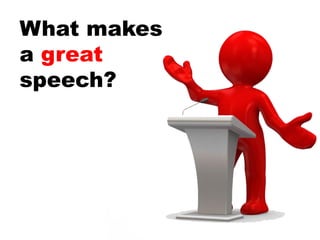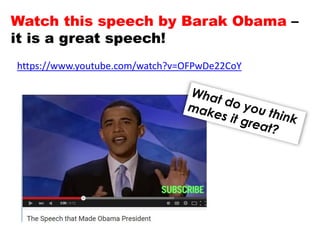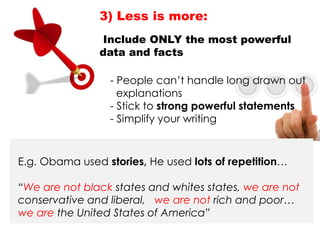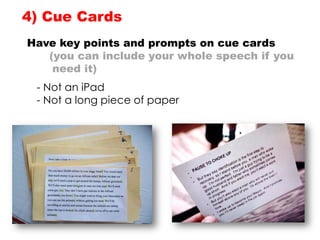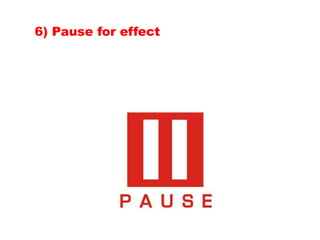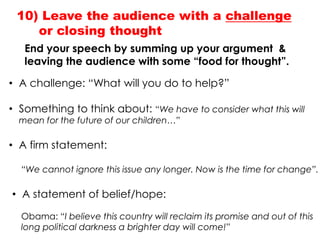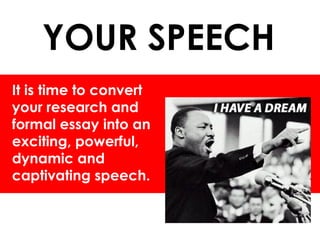Making a speech - Year 9
- 2. Watch this speech by Barak Obama – it is a great speech! https://www.youtube.com/watch?v=OFPwDe22CoY
- 3. Body Language/ Hand Gestures Language & Language devices Use of voice (volume, tone, pauses) Write down what you think is good about the different things he does…
- 4. Can you state your argument in one sentence? 1) What is your main message? E.g. Obama’s Speech – his main message was: “We are the UNITED States of America. That there is only ONE America.”
- 5. -> Try to extract three main points that build your argument 2) What are your 3 key points E.g. We can see three key points in Obama’s speech that all link back to his main message: that we are ONE America. 1) The American Dream – anything is possible 2) We are all interconnected (my story is your story, we are one nation) 3) Hope
- 6. E.g. Obama used stories, He used lots of repetition… “We are not black states and whites states, we are not conservative and liberal, we are not rich and poor… we are the United States of America” 3) Less is more: Include ONLY the most powerful data and facts - People can‟t handle long drawn out explanations - Stick to strong powerful statements - Simplify your writing
- 7. - Not an iPad - Not a long piece of paper 4) Cue Cards Have key points and prompts on cue cards (you can include your whole speech if you need it)
- 8. • It might be a story (e.g. Obama started with the story of his family to identify with the audience) • It might be a „noise” e.g. “BANG”. That is the sound of a harpoon being fired at a whale in the Pacific Ocean. • It might be a rhetorical question – this gets the audience thinking and engaged from the start. 5) Start with a ‘bang’! Engage the audience immediately -> Start with a “hook” – something impacting that will make your audience sit up and listen!
- 9. 6) Pause for effect
- 10. 7) Hand Gestures
- 11. - Increase your volume for something exciting or a very passionate point - Lower your volume again for a more thoughtful or serious point - Use humour where appropriate – it‟s okay to smile! 8) Tone of Voice Use different tones of voice to emphasise your point
- 12. - Personal pronouns - “We” statements – getting the audience on „your side‟ E.g. Obama: “If there is a child who can’t read, that matters to me” “You can make a difference!” “I have a dream!” 9) Making powerful statements
- 13. End your speech by summing up your argument & leaving the audience with some “food for thought”. 10) Leave the audience with a challenge or closing thought • A challenge: “What will you do to help?” • Something to think about: “We have to consider what this will mean for the future of our children…” • A firm statement: “We cannot ignore this issue any longer. Now is the time for change”. • A statement of belief/hope: Obama: “I believe this country will reclaim its promise and out of this long political darkness a brighter day will come!”
- 14. YOUR SPEECH It is time to convert your research and formal essay into an exciting, powerful, dynamic and captivating speech.
- 15. SIMILARITIES AND DIFFERENCES WITH FORMAL WRITING. SIMILARITIES: • Both will have a clear and structured argument • Both will make between 3 and 5 good points • Both will use formal language • Both will use persuasive language techniques (e.g. rhetorical questions, listing, rule of threes, imperative statements, alliteration, onomatopoeia) • Both will make clear links to your research (facts, figures, statistics, case studies and stories) DIFFERENCES: • The speech may use some less formal language where appropriate • The speech may use humour, stories or references to personal experiences or opinions to capture the attention of your audience • The speech will involve structuring what you say to make it easy to say – clearly and powerfully • The speech will need to be delivered with hand gestures, varied tone of voice and changes in volume and expression.
- 16. First – Complete your Introduction 1) What will your “hook” be? What will you use to grab the attention of the audience? -> A question? -> A statement? -> A story? -> A fact e.g. “1 in 10 NZ men will get prostate cancer in their lifetime!” At some point in your introduction, introduce yourself and you topic 2) Gestures & Pauses -> Mark on your page where you will: - Use a hand gesture - Increase the volume of your voice - Pause for effect 3) Practice with a partner -> In the last 10minutes we will practice our introductions with our partner
- 17. Example Student Speech Introduction: Take a moment and ask yourself: What do you see yourself doing in five years? What about ten years? (use hand gestures, pointing towards the audience. Scan the room) If you can‟t answer that question, then maybe it is time to set some goals. (Pause) Good morning, my name is_____ and I‟m here to talk to you about why setting goals is important for everyone. Whether you are 14 or 40, goals help us to have a vision of the future to work towards. Goals are objectives that help us to aim towards improving our life in some way. Many great men and women in history are people of great vision and mission.
- 18. This is what you will be marked on… Achieved Merit Excellence ● voice techniques are used with some variety ● language is formal and includes basic techniques like listing, rhetorical question ● language is suitably mature ● shows awareness of audience through humour, word choice, simple visual aid ● establishes audience attention and interest with humour, quotations or visual aid ● language is formal and includes basic techniques like listing, rhetorical question ● uses voice to support content, such as an accent, tone, volume ● uses purposeful gestures, language, includes statistics, transitions, quotations ● establishes audience rapport by using surprise, or a striking movement ● uses voice to striking effect with little reliance on notes ● uses language techniques such as imperatives and irony ● integrates gestures with impact ● integrates a variety of visual aids with confidence ● presents a topic and purpose ● demonstrates research ● summarises main points ● interprets researched material (express your own understanding of it) ● purpose is reiterated in conclusion ● arranges material in a purposeful structure using frequent links ● uses researched material to support mature insightful points ● leaves the audience with a sense of insight
